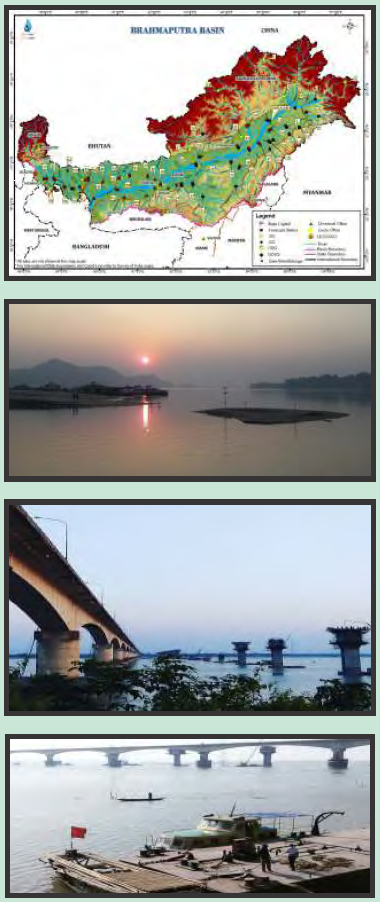Brahmaputra Basin
Brahmaputra Basin
Salient features
- Area of Brahmaputra basin is 580,000 sq.km.
 which covers China (50.5%), India (33.6%), Bangladesh (8.1%) and Bhutan (7.8%). Length in India is 916km
which covers China (50.5%), India (33.6%), Bangladesh (8.1%) and Bhutan (7.8%). Length in India is 916km - Brahmaputra basin spans states of Arunachal Pradesh, Assam, West Bengal, Meghalaya, Nagaland and the whole of Sikkim in India.
- The basin is of irregular shape: the maximum east-west length is 1,540 km and the maximum north-south width is 682 km. The basin lies between 23°N to 32° N latitude and 82°E to 97°50’ E longitude. The part of the Tibetan plateau falling under the basin has an elevation varying from 3,000 to 5,000m and is dotted with numerous glaciers.
- Brahmaputra catchment is the heaviest rainfall region in the world.
- Brahmaputra basin, particularly the portions in Assam, is prone to annual floods and river bank erosions.
- Parts of the Himalayan Mountains region of Sikkim and Arunachal Pradesh falling in Brahmaputra basin experience snow cover.
- As per India WRIS data, Brahmaputra basin represents the greenest part of India, accounting for the maximum 55.48% (107854.26 sq.km.) of country's forest cover.
- In the middle reach of Brahmaputra River is "Majuli", the river island in Assam which is marked as the largest mid river delta system in the world by UNESCO.
- The hydroelectric potential of the Brahmaputra basin has been assessed 66065 MW.
Brahmaputra river
- The river Brahmaputra is one of the largest rivers of the worldwith a specific yield of 85 ha m / sq km, which is next only to Amazon (87 ha m /sq km).
- Brahmaputra River originates in the great glacier mass north of Kailash ranges of Himalayas (elevation 5,150m) & to just south of lake called 'Konggyu Tsho'.
- Brahmaputra traverses a distance of 2,900km through four countries - Tibet (China), Bhutan, India and Bangladesh before entering the Bay of Bengal.
- The source of this river lies in the Kanglung Kang Glacier near the Kailash range of Himalayas located in the south-western part of the Tibetan plateau at an elevation of 5,300m (82°10° E and 30°30’ N) near Konggyu Tso Lake. Here the river is called Tamchok Khambab Kangri. Many snowfed streams join the river from the passes at about 60 km southeast of Mansarovar Lake.
- It has a catchment area of 580,000 sq. km, an average annual discharge of 19,820 cumec, an average annual sediment load of 735 million metric tonnes, and a specific flood discharge of 0.149 cumec/ sq. km.
- The catchment area of the river falls in four countries. Although the main river does not flow through the Kingdom of Bhutan, 96% of Bhutan’s area falls under this basin.
- Important tributaries of Brahmaputra in Indian territory are Subansiri, Kameng (Jiabharali), Dhansiri, Buri-Dihing, Kopili, Manas, Sankosh,Jaldhaka, Torsa and Teesta.
Major projects
To get the list of projects managed by the Brahmaputra Board, click here
Source: : Hydrology and Water Resources Information System for India
Last Modified : 7/26/2024
© C–DAC.All content appearing on the vikaspedia portal is through collaborative effort of vikaspedia and its partners.We encourage you to use and share the content in a respectful and fair manner. Please leave all source links intact and adhere to applicable copyright and intellectual property guidelines and laws.
RELATED ITEMS
Indus Basin
This topic information about the Indus River Basin...
Mahanadi basin
This topic covers information about mahanadi river...
Ganga Basin
This topic provides information about Ganga Basin.
Barak and Others Basin
Provides information about Barak and Others river ...
